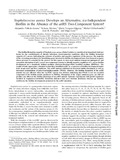Mostrar el registro sencillo del ítem
Staphylococcus aureus develops an alternative, ica-independent biofilm in the absence of the arlRS two-component system
| dc.creator | Toledo Arana, Alejandro | es_ES |
| dc.creator | Merino, Nekane | es_ES |
| dc.creator | Vergara Irigaray, Marta | es_ES |
| dc.creator | Débarbouillé, Michel | es_ES |
| dc.creator | Penadés, José R. | es_ES |
| dc.creator | Lasa Uzcudun, Íñigo | es_ES |
| dc.date.accessioned | 2019-01-21T13:24:44Z | |
| dc.date.available | 2019-01-21T13:24:44Z | |
| dc.date.issued | 2005 | |
| dc.identifier.issn | 0021-9193 (Print) | |
| dc.identifier.issn | 1098-5530 (Electronic) | |
| dc.identifier.uri | https://hdl.handle.net/2454/32028 | |
| dc.description.abstract | The biofilm formation capacity of Staphylococcus aureus clinical isolates is considered an important virulence factor for the establishment of chronic infections. Environmental conditions affect the biofilm formation capacity of S. aureus, indicating the existence of positive and negative regulators of the process. The majority of the screening procedures for identifying genes involved in biofilm development have been focused on genes whose presence is essential for the process. In this report, we have used random transposon mutagenesis and systematic disruption of all S. aureus two-component systems to identify negative regulators of S. aureus biofilm development in a chemically defined medium (Hussain-Hastings-White modified medium [HHWm]). The results of both approaches coincided in that they identified arlRS as a repressor of biofilm development under both steady-state and flow conditions. The arlRS mutant exhibited an increased initial attachment as well as increased accumulation of poly-N-acetylglucosamine (PNAG). However, the biofilm formation of the arlRS mutant was not affected when the icaADBC operon was deleted, indicating that PNAG is not an essential compound of the biofilm matrix produced in HHWm. Disruption of the major autolysin gene, atl, did not produce any effect on the biofilm phenotype of an arlRS mutant. Epistatic experiments with global regulators involved in staphylococcal-biofilm formation indicated that sarA deletion abolished, whereas agr deletion reinforced, the biofilm development promoted by the arlRS mutation. | en |
| dc.description.sponsorship | This work was supported by the BIO2002-04542-C02 and GEN2003-20234-C06-05 grants from the Comisión Interministerial de Ciencia y Tecnología and grant 17/2004 from the Departamento de Educación y Cultura del Gobierno de Navarra, Spain. | en |
| dc.format.extent | 12 p. | |
| dc.format.mimetype | application/pdf | en |
| dc.format.mimetype | application/zip | en |
| dc.language.iso | eng | en |
| dc.publisher | American Society for Microbiology | en |
| dc.relation.ispartof | Journal of Bacteriology, Aug. 2005, Vol. 187, No. 15, p. 5318–5329 | en |
| dc.rights | © 2005, American Society for Microbiology. All Rights Reserved. | en |
| dc.subject | Staphylococcus aureus | en |
| dc.subject | arlRS | en |
| dc.subject | Biofilm development | en |
| dc.title | Staphylococcus aureus develops an alternative, ica-independent biofilm in the absence of the arlRS two-component system | en |
| dc.type | info:eu-repo/semantics/article | en |
| dc.type | Artículo / Artikulua | es |
| dc.contributor.department | IdAB. Instituto de Agrobiotecnología / Agrobioteknologiako Institutua | es |
| dc.rights.accessRights | info:eu-repo/semantics/openAccess | en |
| dc.rights.accessRights | Acceso abierto / Sarbide irekia | es |
| dc.identifier.doi | 10.1128/jb.187.15.5318-5329.2005 | |
| dc.relation.publisherversion | https://doi.org/10.1128/jb.187.15.5318-5329.2005 | |
| dc.type.version | info:eu-repo/semantics/publishedVersion | en |
| dc.type.version | Versión publicada / Argitaratu den bertsioa | es |
| dc.contributor.funder | Gobierno de Navarra / Nafarroako Gobernua | es |


